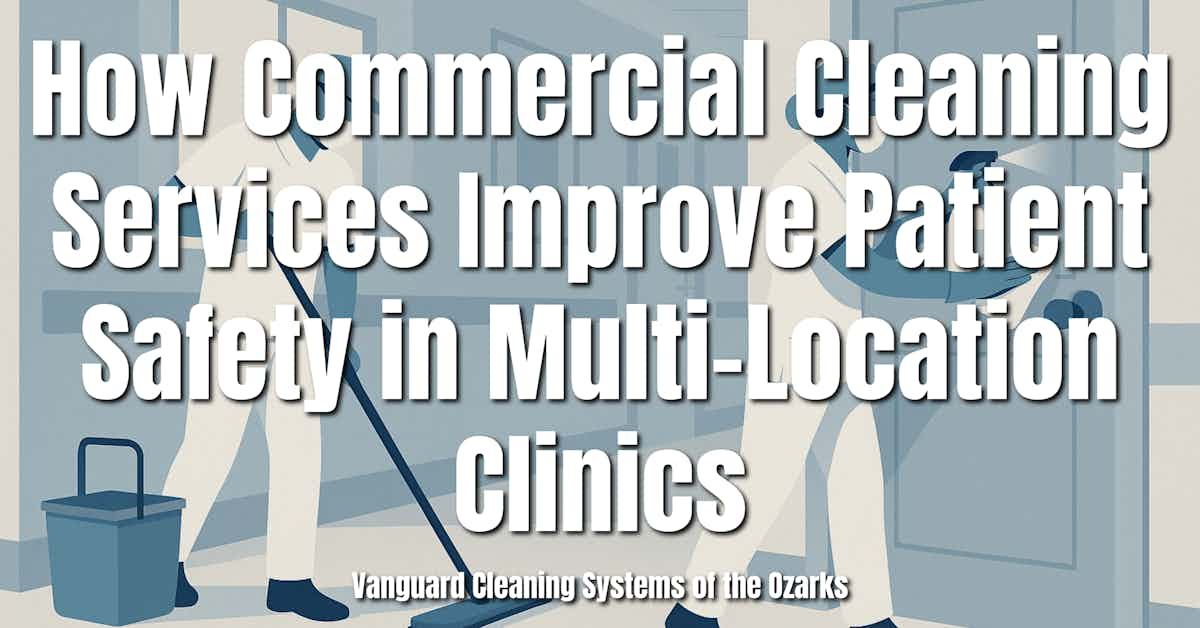Inconsistent cleaning practices across clinic locations can silently compromise patient safety—but commercial cleaning services close that gap with precision, consistency, and compliance.

Closing the Safety Gap in Outpatient Clinics with Professional Cleaning
In multi-location clinics, patient safety hinges on more than clinical excellence—it depends on the environment. As healthcare delivery expands into outpatient settings, inconsistent sanitation practices across sites create avoidable risks for infection transmission. Evidence shows that many ambulatory clinics struggle with cleaning thoroughness, particularly in high-touch areas and shared spaces.
Professional commercial cleaning services directly address this gap by introducing standardized protocols, measurable compliance, and enhanced infection control readiness. Structured cleaning frameworks have demonstrated significant improvements in cleanliness scores, even in resource-limited settings, without requiring substantial investment. By centralizing hygiene accountability, multi-site operators can raise patient safety standards while improving operational efficiency and regulatory alignment.
Structured Cleaning Programs Improve Infection Control
Standardized cleaning programs are proven to elevate infection prevention across diverse healthcare environments. In multi-location clinics, applying a uniform cleaning protocol ensures consistent quality regardless of facility size, staff turnover, or resource variation. These programs often follow stepwise models that include initial assessments, staff training, progress monitoring, and public recognition—each phase reinforcing accountability and measurable outcomes.
Results from structured interventions show dramatic increases in sanitation compliance. For example, baseline facility hygiene scores often begin below 50% and, through methodical implementation of structured programs, rise to over 85%. Improvements span critical areas including delivery rooms, emergency wards, and postnatal care units. These gains are not driven by capital upgrades but by systematized process changes—proof that strategic oversight can achieve clinical-grade cleanliness without clinical staff distractions.
Inconsistency in Cleaning Undermines Patient Safety
Many outpatient clinics rely on a mix of medical assistants and internal staff for cleaning tasks, leading to wide variations in performance. Studies of ambulatory care settings reveal that high-touch areas—such as exam tables, chair arms, and light switches—are frequently missed or inconsistently cleaned. Waiting rooms show the lowest compliance, with surface cleaning rates often falling below 10%.
This inconsistency not only elevates the risk of healthcare-associated infections but also erodes patient trust. Unlike hospitals with dedicated environmental services teams, smaller clinics often lack formal training programs and routine audit mechanisms. Without a unified standard or external accountability, even well-intentioned efforts fall short of acceptable hygiene thresholds. Commercial cleaning services resolve this by delivering regimented procedures that cover all zones of a facility, ensuring no area is overlooked.
Protect Patients with Professional Healthcare Cleaning
Ensure consistent infection control across all clinic locations with our expert healthcare sanitation services.
Professional Cleaning Services Reduce Human Error and Elevate Standards
In clinical environments, small mistakes in cleaning protocols—like improper disinfectant dilution or overlooked surface compatibility—can lead to significant infection risks. Commercial cleaning services eliminate these variables by deploying trained personnel who follow validated procedures using healthcare-grade products. Their methods are engineered to reduce variability, preserve facility assets, and meet regulatory standards.
Professional services also introduce technologies and workflows that typical clinic staff may not be equipped to manage. These include color-coded cleaning systems, cross-contamination controls, and data-driven performance audits. Unlike ad hoc internal efforts, commercial teams are subject to third-party oversight, allowing for greater transparency and continual process improvement. For multi-location clinics, this ensures each facility upholds the same high standard—regardless of local staffing or operational complexity.
Human Factors and Workflow Challenges Impact Cleaning Effectiveness
Environmental cleaning in clinical settings is deeply influenced by human and organizational factors. In many multi-location clinics, cleaning responsibilities are layered onto overburdened staff, resulting in inconsistent execution. Variables such as patient flow, room occupancy, time constraints, and unclear role definitions create friction that reduces cleaning compliance—especially in shared or high-turnover spaces.
Facilities with multibed rooms or active patient presence report greater difficulty maintaining hygiene standards, particularly when cleaning is performed without dedicated personnel. Organizational issues like staffing shortages, lack of routine training, and limited access to cleaning supplies further compound the problem. Commercial cleaning providers address these challenges with defined workflows, specialized training, and equipment standardization that eliminate ambiguity and reduce dependence on clinical staff. The result is a more controlled, repeatable process that improves safety without disrupting patient care.
Global Safety Standards Reinforce the Need for Professional Hygiene Protocols
International health organizations emphasize that environmental hygiene is foundational to patient safety, especially in outpatient care. Global initiatives like the World Health Organization’s “Clean Care is Safer Care” campaign highlight that simple practices—such as proper hand hygiene and systematic surface disinfection—can dramatically reduce healthcare-associated infections.
Despite the simplicity of these practices, sustained compliance requires more than awareness. Clinics must implement systems that make these behaviors automatic, auditable, and scalable. Commercial cleaning services align with these global mandates by delivering structured, repeatable protocols that match or exceed international standards. For multi-location clinics, this alignment enhances credibility, supports accreditation efforts, and ensures that each facility can meet evolving regulatory expectations without developing separate internal programs from scratch.
Standardized Cleaning Services Add Strategic Value Across Locations
Multi-location clinics face unique operational challenges—geographic dispersion, variable staffing, and inconsistent infrastructure—which make uniform infection control difficult to achieve internally. Commercial cleaning services solve this by offering scalable systems that ensure every facility maintains the same standard of cleanliness, regardless of size or location.
This standardization streamlines compliance with health regulations, simplifies training requirements, and reduces administrative burden. It also enhances brand integrity by ensuring patients encounter a consistently clean and professional environment, whether visiting a flagship location or a satellite office. Additionally, commercial providers offer performance metrics, reporting tools, and service audits that help clinic networks measure ROI, mitigate risk, and support future expansion plans without compromising patient safety.
FAQ: Protecting Patients Through Professional Cleaning in Outpatient Clinics
What role does commercial cleaning play in patient safety?
Commercial cleaning services provide structured, consistent sanitation protocols that reduce infection risk, particularly in high-touch and high-traffic areas often missed by clinical staff.
Why are internal cleaning efforts in clinics often insufficient?
Internal staff frequently lack dedicated training, standardized workflows, and performance auditing tools, leading to wide variation in cleaning quality across locations and staff shifts.
How does standardized cleaning improve outcomes in multi-location settings?
Standardized commercial cleaning ensures every clinic operates under the same protocols, reducing compliance gaps and enabling centralized oversight and quality assurance.
What are the operational benefits of outsourcing clinic cleaning?
Outsourcing reduces training burden on medical staff, provides audit-ready documentation, minimizes liability, and helps maintain a consistent brand experience across facilities.
Can commercial cleaning services meet global infection control standards?
Yes. Leading providers implement evidence-based practices that align with international standards such as those outlined by the WHO and CDC, supporting clinical-grade disinfection without disrupting care delivery.
References
- Pittet, D., & Pittet, D. (2010). WHO First Global Patient Safety Challenge: Saving Lives in Healthcare Through Clean Hands. Infection, 38, 79-80. https://doi.org/10.1007/s15010-010-3089-y
- Mckinley, L., Goedken, C., Balkenende, E., Sherlock, S., Reisinger, H., Knobloch, M., Perencevich, E., & Safdar, N. (2021). A Qualitative Work System Analysis Using a Human Factors Engineering Approach to Evaluate Environmental Cleaning in Veterans’ Affairs Hospitals. Antimicrobial Stewardship & Healthcare Epidemiology : ASHE, 1, s62 - s63. https://doi.org/10.1017/ash.2021.121
- Fedko, N., Malkina, L., & Shilo, D. (2023). Experience of implementing professional cleaning technologies in a modern medical organization. Meditsinskaya sestra. https://doi.org/10.29296/25879979-2023-06-05
- Rupp, M., Olson, C., Cavalieri, R., Lyden, E., & Carling, P. (2017). How Clean Are the Clinics? Assessment of Environmental Cleanliness in Ambulatory Care. Open Forum Infectious Diseases, 4, S183 - S184. https://doi.org/10.1093/OFID/OFX163.338
- Lopez, J., Sierra, S., Cardona, A., & Sara, S. (2020). Implementing the Clean Clinic Approach Improves Water, Sanitation, and Hygiene Quality in Health Facilities in the Western Highlands of Guatemala. Global Health: Science and Practice, 8, 256 - 269. https://doi.org/10.9745/GHSP-D-19-00413
Conclusion
Commercial cleaning services provide more than surface-level benefits—they serve as a critical safeguard for patient health in multi-location clinics. By standardizing hygiene practices, reducing error, and addressing systemic workflow challenges, these services create safer clinical environments across all sites. Clinics that adopt professional cleaning solutions not only improve infection control outcomes but also position themselves for regulatory compliance, operational efficiency, and patient trust. In a healthcare landscape where safety and perception are closely linked, professional cleaning is not an expense—it’s a strategic asset.
Vanguard Cleaning Systems® of the Ozarks' franchise-owned custodial service provider business cleans more than 8M sq. ft. weekly, maintaining an industry-topping 95+% of its customer base, year-over-year, and boasting more than 60 5-star Google reviews.
Need more capability from your vendor partners? --Let's talk.
In Oklahoma, dial 918-960-4450
In Arkansas, dial 479-717-2410
In Missouri, dial 417-812-9777

